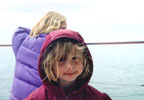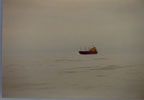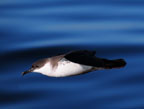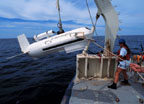|

|
A humpback whale breaches
next to a whale watching vessel. New guidelines for
whale watching have been issued by the National
Marine Fisheries click image for
more...(photo: Anne Smrcina)
|
|

|
Children as well as adults
enjoy the thrill of seeing the majestic whales up
close. For whale watch trips in the spring and
fall, its best to dress very warmly as click
image for more.. (photo: Anne Smrcina)
|
|

|
The major shipping lanes to
Boston take tankers and other large vessels right
through the middle of the sanctuary. On hazy or
foggy days, at night or on days with rough seas
whales may be hard to see. (photo: Anne
Smrcina)
|
|

|
A collision and propeller
cuts from a large ship killed this right whale (it
is not known where the strike occurred). A
mandatory click image for more... (photo:
Center for Coastal Studies)
|
|

|
Large numbers of boats travel
into the sanctuary to watch whales. Scientists are
interested in knowing whether sound levels are loud
enough to click image for more...(photo:
Brad Barr)
|
|

|
Whales can get entangled in
lines and fishing gear, leading to potentially
life-threatening situations. On-going research is
looking at click image for more... (photo:
New England Aquarium)
|
|

|
For bird watchers, the
sanctuary is a popular destination. During summer,
birders can travel out to Stellwagen Bank with any
of the whale watch tours to see a variety of
species,click image for more...(photo: Dann
Blackwood, USGS)
|
|

|
At one time great auks spent
their winters on Stellwagen Bank. However, in 1844,
ten years before Stellwagen Bank was mapped, the
last of the great auks was killed. Humans use of
marine resources is the focus of a new sanctuary
education package. (photo: Anne Smrcina)
|
|

|
Recreational and commercial
fishing boats have easy access to the sanctuary
from Cape Cod and Cape Ann. Boston, pictured here,
is just 25 miles directly west. (photo: Dan
Blackwood, USGS)
|

|
A purse seine boat travels
through the sanctuary as it searches for schools of
tuna. This fishing method involves click image
for more... (photo: Dann Blackwood,
USGS)
|
|

|
Trawlers use nets that sweep
across the bottom, held open by "doors" on each
side of the net. The contents of the net are
emptied click image for more... (photo:
Center for Coastal Studies)
|
|

|
The seafloor shows markings
after the passage of trawl fishing gear. Heavily
fished areas no longer have any significant amount
of three-dimensional cover. (photo: Peter Auster
and Paul Donaldson, NURC, Uconn)
|

|
Sea turtles, like this
leatherback, can also get caught up in debris. Not
only was this animal entangled, but a necropsy
revealed a click image for more... (photo:
Doug Beach)
|
|

|
Scientists from the US
Geological Survey lower SeaBoss (Sea Benthic
Observation Sampling System), a frame with video
and still imaging systems and sampling equipment.
(photo: Dan Blackwood, USGS)
|
|

|
A sub-bottom profiler allows
geologists to get data about the seafloor and the
structure below. (photo: Dan Blackwood,
USGS)
|

|
Kraken, a remotely-operated
vehicle is launched by scientists from the National
Undersea Research Center, University of
Connecticut. An operator at the surface directs the
"robot" to specific targets for photography or
sampling activities. (photo: National Undersea
Research Center - UConn)
|

|
Neither rain nor storms will
sway these researchers from their appointed rounds.
Here, a naturalist dredge is being readied for
benthic sampling. (photo: (photo: Peter Auster,
National Undersea Research Center - UConn)
|

|
Subs, like Clelia, have been
used by the National Undersea Research Center and
other research institutions to study the sanctuary.
This sub is operated by the Harbor Branch
Oceanographic Institution. (photo: Brad
Barr)
|
|

|
An informational kiosk on sanctuary resources
has been placed at MacMillan Wharf in Provincetown,
a center for whale watching on Cape Cod. (photo:
Brad Barr)
|

|
The sanctuary has hosted the MIMI sailing vessel
for week-long MIMI Fests and is using the vessel as
a research platform during the Sustainable Seas
Expedition. A widely used middle school curriculum
is based on the exploits of the MIMI's crew.
(photo: Anne Smrcina)
|